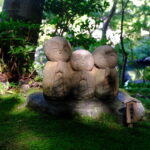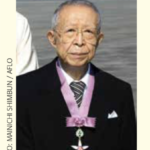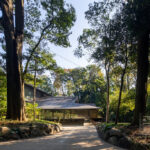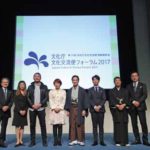The Grand Egyptian Museum will open in Cairo next year with Japanese conservation and restoration experts continuing to play a vital role.
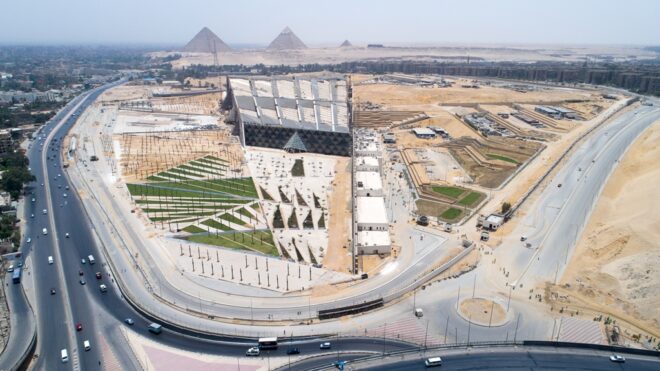
The Grand Egyptian Museum under construction. The Pyramids of Giza are visible in the background. • COURTESY OF JICA
Pyramids and mummies are some of the most famous examples of Ancient Egypt’s cultural legacy, which still remain to this day in modern Egypt. Tourists flock to this African nation from around the world to see these artifacts. The Museum of Egyptian Antiquities, located on the Nile in Cairo, is one of the best places for tourists to immerse themselves in this rich history. The museum’s collection includes more than 200,000 historic cultural assets of ancient Egypt, such as carved statues, stone coffins, antiquities and ancient pharaohs’ mummies. Particularly famous are the items that belonged to King Tutankhamun. The many special treasures that are the museum’s main attraction, such as golden masks and pharaohs’ thrones and coffins, are on display for the enrichment of the visiting public.
But the museum, which was built in 1902, is outgrowing its building. Space limitations are resulting in a vast amount of the museum’s collection being relegated to storage, unexhibited. Because of the limitations of the museum’s property, it is difficult to enlarge the museum.
The tourism industry is one of Egypt’s primary sources of foreign currency revenue, and development of the tourism industry is strongly expected to benefit the Egyptian economy and create jobs, a serious issue in Egypt. In particular, the effective utilization of the nation’s historic cultural heritage, which is Egypt’s biggest tourism resource, is a crucial challenge in boosting the appeal of the tourism industry. For this reason, a new museum—the Grand Egyptian Museum (GEM)—is being constructed just next to the Pyramids of Giza, about 15 kilometers southwest of Cairo. In 2006, in response to a request from the Egyptian government, the Japanese government promised support for the construction of GEM, marking the full-scale start of the project. Japan provided support funding in the form of about 84 billion in yen loans toward the estimated 140 billion yen construction costs, and construction work started in 2012.
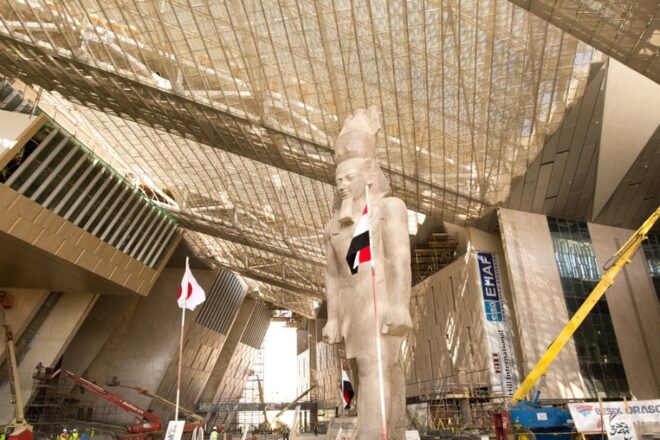
Installation in the Grand Egyptian Museum of the statue of Ramesses II • COURTESY OF JICA
GEM has an estimated capacity of about 100,000 cultural assets, and artifacts including about 5,000 of King Tutankhamun’s great treasures are planned to be consolidated from The Egyptian Museum, and museums and storehouses across Egypt. GEM will not only exhibit cultural assets but also conduct education and research, and is expected to be the center of Egyptian studies.
The GEM-CC
In parallel with the construction of GEM, in 2008 the Japan International Cooperation Agency (JICA) started collaborating with the Egyptian government in the Project for the Conservation Center in the Grand Egyptian Museum. The core of this project is the GEM-CC, which was built in 2010 by the Egyptian government next to the GEM. The GEM-CC is equipped with seven specialized conservation laboratories for different materials: stones and mural paintings, wood, inorganic artifacts, organic artifacts and mummies. There are also six scientific analysis laboratories including a scanning electron microscope (SEM) lab, optical microscope lab, experimental conservation materials lab, a repository, a fumigation room to protect cultural assets, and a library.
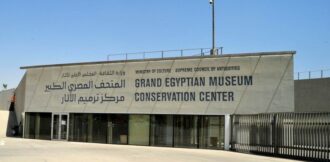
The Conservation Center (GEM-CC) on the grounds of the Grand Egyptian Museum • COURTESY OF JICA
“The Conservation Center was established for the purpose of conserving cultural assets the Egyptians are proud of, and nurturing engineers who engage in conservation work,” says Takeshita Masataka, director of JICA’s Middle East Division 1. “This Center values the importance of training African, Near, and Middle Eastern conservators and curators, and transferring conservation techniques to other countries.”
Phase 1 of the project was conducted from 2008 to 2011. Phase 2 picked up in 2011 and continued until 2016. The ongoing Phase 3 began in 2016. In Phase 1, JICA mainly provided support for constructing cultural asset databases. To open GEM, it was important to first identify the cultural assets to be displayed, and safely transport them.
Accurate cultural asset databases are indispensable for that. You need to collect many types of information, such as the type and size of each cultural asset, where they are kept in storage, the conditions in which they are stored, and whether they have been restored or not, into the databases. The process of building the GEM databases had begun before the project officially kicked off, but the data included entry errors and redundancies and the information was not accurate enough for the task. In response to this, JICA consulted with the Egyptians and established the Archeological Database Department (ADD) to reconstruct the existing databases under the direction of JICA database experts.
ADD staff visited the Egyptian Museum and other museums and storehouses in many parts of Egypt to individually check cultural assets destined for GEM and confirm and correct data, including registration numbers. They measured the size and weight of those cultural assets, and took photos of them, entering this data into the databases.
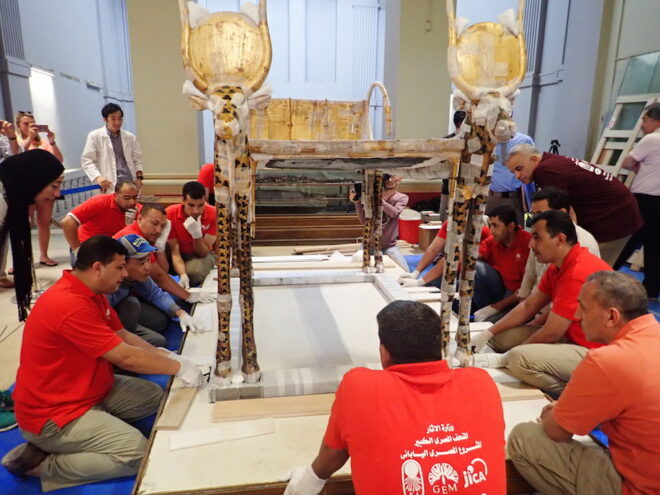
Japanese and Egyptian experts oversee the transfer of the funerary bed of King Tutankhamun to GEM-CC • COURTESY OF JICA
As for development of the human resources who work for the conservation of cultural assets, which is a core of the project, many workshops, training sessions and symposiums have been held in Japan and Egypt. These events have covered study and training sessions on different restoration techniques for different materials, such as paper, dyed items, and metals, and mastering conservation materials, diagnosis, and analysis techniques. A training session on washi, Japanese paper, was held for the mastering of conservation materials. Japan has many cultural assets made from washi, such as paintings, ancient documents, and other crafts, so techniques to restore those cultural assets have been developed. Today the preservation techniques developed to make and preserve washi are widely used in Western countries as well. At a training session that was held at the GEM-CC in 2012, specialists who were sent from Japan conveyed the process and techniques of making washi used to conserve cultural assets and the pastes that are used together with washi to Egyptians in charge of conservation work. The lessons imparted in the training session are already being applied to conservation work being conducted by the Egyptians.
In addition, human resources engaged in the packing and transporting of cultural assets are also developed. At a training session, employees in charge of art items at Nippon Express, a leading Japanese transportation company, transferred techniques for the safe packing and transporting of cultural assets. They also conducted a wide variety of practical training, such as methods for drawing up transportation plans, proper measurement of artifacts, the packing of fragile artifacts, and the careful transportation of heavy items by crane, which resulted in improving Egyptian techniques.
“Initially, some Egyptians in charge thought that when they transported cultural assets, some damage was unavoidable. But Japanese specialists’ way of thinking, that one should never cause any damage to cultural assets, spread through the Egyptian side as well and their awareness changed greatly,” says Takeshita. “Egyptians took ownership and drew up their own manual for transporting cultural assets.”
Looking Toward the Opening of the Museum
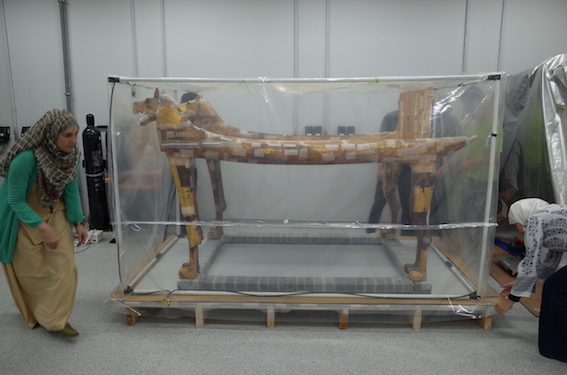
King Tutankhamun’s ritual bed undergoes fumigation • COURTESY OF JICA
Currently, GEM is planned to open in 2020. The building has almost been completed and the interior will be finished in a year. The GEM-CC has conducted technical training using replicas to help engineers acquire and improve conservation skills. But now the GEM-CC is working on restoring real cultural assets that will actually be exhibited. In the current project with JICA, they are focusing on fields that are important for the opening of GEM and are suitable for the transfer of techniques, selecting seventy-two target artifacts, such as wooden items, dyed items and stones and mural paintings, from among the huge collection of cultural assets. They classified them into ten lead artifacts and sixty-two follow artifacts. Lead artifacts are the hardest to conserve and are the ones that require an extremely high level of technical knowledge and capability. Japanese and Egyptian experts collaborate in conserving lead artifacts. Follow artifacts are ones whose conditions and nature are similar to those of lead artifacts, and the knowledge and techniques used for conserving lead artifacts can be applied to follow artifacts. Japanese and Egyptian experts collaborate in diagnosing and analyzing follow artifacts and drawing up conservation plans, but the conservation work is conducted by Egyptians.
All the target artifacts have already been transported to the GEM-CC and each team in charge of wooden items, textile items and stones and mural paintings is working on analyzing, diagnosing and conserving them. For example, the team in charge of wooden items is conducting a non-destructive analysis of King Tutankhamun’s chariot and bed utilizing X-rays, digital microscopes and electron microscopes, identifying traces of previous restorations and deteriorated parts. This analysis enables engineers to decide how to conserve cultural assets.
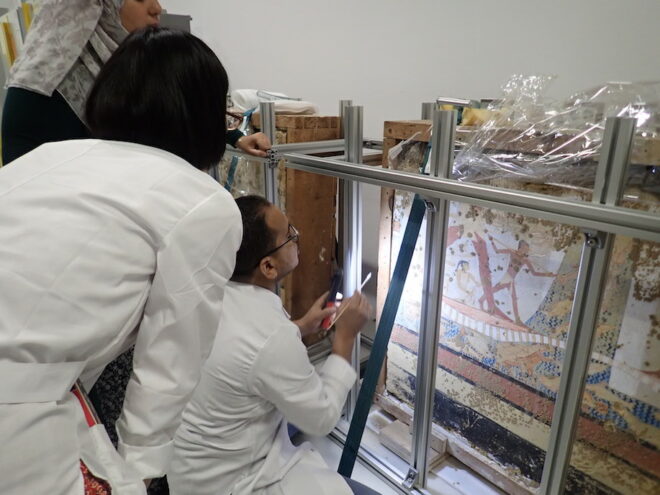
Mural Painting Lab experts scrutinize a painting • COURTESY OF JICA
As soon as the mural paintings are transported to the GEM-CC, they are isolated in a tent and are fumigated by nitrogen gas. After fumigation, the team in charge of mural paintings fills the fragile parts of the paintings with conservation materials and injects the cracks for consolidation.
Since 2016, JICA has also been implementing a Capacity Development Project for Management and Exhibition of the Grand Egyptian Museum in addition to the GEM-CC in preparation for the opening of GEM. In this project, JICA provides support, nurturing the human resources who work on formulating plans necessary for the independent management of GEM, building a management and implementation structure, formulating funding plans necessary for the management of museums, educational and promotional activities, and using information technology to develop exhibitions.
“The GEM project had faced many challenges but the opening of the Museum finally draws nearer,” says Takeshita. “GEM has great potential. JICA will continue to provide necessary support so that GEM will be managed smoothly by Egyptians in the future, eventually leading to the creation of new industries and jobs.”
By SAWAJI Osamu, The Japan Journal



